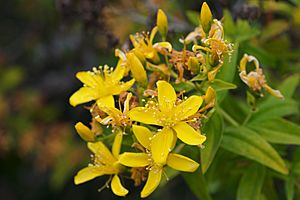Canary Islands St facts for kids
Quick facts for kids Canary Islands St |
|
|---|---|
 |
|
| Conservation status | |
| Scientific classification | |
| Genus: |
Hypericum
|
| Species: |
canariense
|
| Varieties | |
|
|
| Synonyms | |
|
|
The Hypericum canariense is a type of flowering plant often called the Canary Islands St. John's wort. It belongs to the plant family Hypericaceae. This plant is the only member of a special group called Hypericum sect. Webbia.
Contents
What's in a Name? The Hypericum canariense Story
This plant has many interesting names! In Spanish, people call it granadillo, espanta demonios (which means "demon scarer"), flor de cruz ("cross flower"), and leña de brujas ("witch's firewood"). In Finnish, it's known as Kanariankuisma.
The scientific name canariense tells us where it comes from. It refers to the Canary Islands, where this plant grows a lot. That's why its common names include Canary Islands St. John's wort or Canary Islands Hypericum.
Where Does the Canary Islands St. John's Wort Grow?
This plant naturally lives only in the Canary Islands and Madeira. It grows on the five westernmost islands. You can find it on dry, bushy hillsides and in forests. It usually grows at heights from about 150 to 800 meters (around 500 to 2,600 feet).
The Hypericum canariense has also been brought to other places. These include Australia, New Zealand, and parts of the United States like California and Hawaii. In these new places, it was often planted as an ornamental plant (for decoration). Sometimes, it escapes from gardens and grows wild, becoming a minor noxious weed.
What Kind of Home Does Hypericum canariense Like?
The Canary Islands St. John's wort can grow in different types of soil. It likes clay, sandy soil, and a mix called loam. You can often spot it growing along streams and next to roads. It also thrives in dry, scrubby areas and in moist forests. It often grows near another plant called Globularia salicina.
What Does the Canary Islands St. John's Wort Look Like?
This plant is a flowering shrub that can grow quite tall, usually between 2 to 3 meters (about 6.5 to 10 feet) high. It has many stems with waxy, lance-shaped leaves. These leaves are about 5 to 7 centimeters (2 to 2.7 inches) long.
When it blooms, it has lots of bright yellow flowers. Each flower has five petals, which are a bit over a centimeter long. Inside the flower, there are many yellowish, whiskery stamens (the parts that produce pollen).
The plant makes new plants in two ways. It can grow from seeds found in its dry fruits. It can also spread underground using special stems called rhizomes, which is a type of vegetative reproduction.
Sometimes, people confuse this plant with others. It looks similar to H. canadense or Peritoma arborea. This is because they have similar flowers and large stamens.
Different Types of Hypericum canariense
There are three recognized types, or varieties, of this plant:
- H. canariense var. canariense
- H. canariense var. floribundum (Dryand. ex Ait.) Bornm.
- H. canariense var. platysepalum (Webb & Berth.) Ceb. & Ort.
See also
 In Spanish: Hypericum canariense para niños
In Spanish: Hypericum canariense para niños


